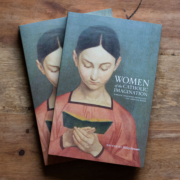On Thursday, June 13, 2024, the Dicastery for Promoting Christian Unity (DPCU) published a new document on the papacy: The Bishop of Rome: Primacy and Synodality in the Ecumenical Dialogues and in the Responses to the Encyclical Letter Ut Unum Sint. Here, I offer an overview of the background and contents of the document.
Background
Pope St. John Paul II promulgated the encyclical Ut Unum Sint on May 25, 1995. The theme was the Church’s commitment to ecumenism. Therein, he famously wrote of his desire “to find a way of exercising the primacy which, while in no way renouncing what is essential to its mission, is nonetheless open to a new situation” (95). He encouraged theologians from various Christian Churches and ecclesial communities to investigate the issue of papal primacy, which—although it is chiefly a ministry of unity—remains one of the chief points of division between Catholics and other Christians.
Given the requirement of not renouncing anything essential to Catholic dogma on the papacy, the task of finding “forms in which this ministry may accomplish a service of love recognized by all concerned”1 is difficult indeed. Nevertheless, many ecclesial communities and ecumenical dialogue commissions have responded to that invitation.
This new document provides a synthesis of such responses and “concludes with a brief proposal of the 2021 Plenary Assembly of the Dicastery, entitled ‘Towards an Exercise of Primacy in the 21st century,’ which identifies the most significant suggestions put forward by the various responses and dialogues for a renewed exercised of the ministry of the unity of the Bishop of Rome.”2 In other words, it is not a magisterial text but a study document that collates the results of ecumenical endeavors regarding the papacy and appends in a complementary text what the Dicastery finds to be the most promising proposals. The intended audience is scholars and ecumenists to aid them in their continued efforts (see 9). It is neither intended nor written for a popular audience. Furthermore, the presence of any given perspective or suggestion does not mean approval or agreement on the part of the DPCU nor of the Magisterium in general.
Non-Catholic voices are beginning to open up to the importance of universal primacy in the service of ecclesial unity.
In preparing the text, the DPCU solicited input from various other Vatican dicasteries as well as from theologians from a variety of Christian communities (see Preface and 10). Notably, the Dicastery’s officials “promoted and coordinated the project in collaboration with the Institute for Ecumenical Studies of the Angelicum” (Preface). The Angelicum is the Pontifical University of St. Thomas Aquinas run by the Order of Preachers (Dominicans) and is renowned for its orthodoxy and dedication to Thomistic theology.
Contents of the Study Document
Content-wise, there are really two documents bound and published together. The first and longest of these is the main study document. The second is the aforementioned proposal from the Dicastery’s 2021 plenary assembly, which is based on the first document.
The main study text is comprised of an introduction, four chapters, and a summary. The introduction starts with a consideration of papal interventions on the topic followed by an explication of the origin, aim, and structure of the document as a whole.
Chapter 1, “Ecumenical Reflection on the Ministry of the Bishop of Rome,” enumerates responses to Ut Unum Sint from “a broad spectrum of Christian communions” (12) as well as documents born out of ecumenical theological dialogues (see 11). Responses were received from “Old Catholic Churches, Churches of the Anglican Communion, Lutheran Churches, Presbyterian Churches, Reformed Churches and Free Churches” (12). Additional responses were drafted by ecumenical bodies, such as the Faith and Order Commission of the World Council of Churches (see 13). The document further names significant conferences and symposia held in response to Ut Unum Sint (see 14).
Section 1.2 (15–30) provides an impressively long list of documents stemming from various official and unofficial, international and regional/national dialogues that treat the question of the papacy either exclusively or in a broader context, adding at the end a short list of responses to some of these documents. Helpfully, it organizes the list according to the dialogue bodies that produced them. Such bodies include the “Joint International Commission for Theological dialogue between the Roman Catholic Church and the Orthodox Church (as a whole)” (16), various national level Catholic-Orthodox groups and one unofficial international Catholic-Orthodox group (17), dialogue with Oriental Orthodox Churches (18), as well as ecumenical commissions (or equivalent) involving dialogue between the Catholic Church and Anglicans, Lutherans, Reformed, Methodists, Old Catholics, Evangelicals, Pentecostals, Baptists, Mennonites, and a community simply called “Disciples” (18–29).
In light of the above, the document continues: “One can conclude from this overview of the responses and dialogue agreements that the issue of papal primacy has been intensively discussed in almost all ecumenical contexts during the last decades: in all, about 30 responses and 50 dialogue documents were at least partially dedicated to the topic” (31). In fact, even dialogues between non-Catholic communities have addressed the topic, showing a renewed interest in—as well as less hostile attitudes regarding—the idea of a universal office serving ecclesial communion. A list of the responses and dialogue documents is provided in the back of the document under “Sources,” again organized according to the originating groups.
After the textual synopsis, Chapter 2 (33–73) treats “Fundamental Theological Questions,” including those that have most typically challenged papal primacy as well as positive developments in ecumenical reflections (see 11 and 33). In particular, it treats biblical data (Section 2.1), the existence of the papal office de jure divino (by divine right) (Section 2.2), and Vatican I’s dogmatic definitions regarding papal jurisdiction and infallibility (Section 2.3). In each of these sections, response and dialogue documents are quoted in a synthetic manner, providing a helpful synopsis of their approach to the pertinent questions. In addition to challenging Catholics to be balanced and to avoid anachronism, such texts also show a profound willingness on the part of non-Catholics to acknowledge Peter’s special role within the New Testament Church as well as, in some cases, to affirm the need for a universal, episcopal office that serves ecclesial unity.

Chapter 3 presents “some perspectives for a ministry of unity in a reunited Church” (11). It thus presents proposals that are at once hypothetical and practical: How would a universal ministry serving unity function in practice if all Christians were to be reunited? First, section 3.1 addresses whether such a universal ministry is necessary. Thankfully, in agreement with the Catholic position, “many theological dialogues and responses to Ut unum sint acknowledged the requirement of a primacy for the entire Church” (75). Section 3.2 considers evidence from the first millennium of Church history, considering it a decisive criterion. Section 3.3 articulates principles for how primacy ought to function in the current century, including its relation to collegiality and to local and regional levels of Church structure.
Chapter 4 synthesizes “practical suggestions or requests addressed to the Catholic Church” (11). Some suggestions and requests were: (1) that the Catholic Church consider interpreting Vatican I in a way that is faithful to its intention but with newer modes of expression that might be better received in the current context. One suggestion was to describe infallibility in terms like “promise, trust, and hope” rather than “law, obligation, and obedience” (146). Another request was that the Catholic Church more clearly articulate and differentiate the various roles of the bishop or Rome (Section 4.2). Essentially, this request simply means being more explicit about what the Church already holds, that the bishop of Rome is simultaneously but distinctly (1) bishop of the diocese of Rome, (2) primate of the Western/Latin Church, and (3) universal minister of unity. Instead of only focusing on this last role, it should be clearer when he is acting in the other two capacities alone. Sections 4.3 and 4.4 present suggestions for the Church acting synodally both ad intra and ad extra, respectively.
The Summary, as expected, simply gives a brief recapitulation of the above chapters. More expansively, the proposal from the Plenary Assembly of the DPCU (the second, appended document) indicates what the Dicastery found to be the most helpful suggestions, makes its own suggestions for further steps for dialogue, and articulates principles and additional suggestions for a renewed papacy that might be more amenable to all Christians.
Conclusion
As a theologian who has done some research and writing in the area of the papacy and ecumenism (mostly with regard to Catholic-Orthodox dialogue), I find the new study document from the DPCU to be helpful from a scholarly perspective. It serves as a bibliographical repository and summary of several dozen important texts about the papacy originating from ecumenical efforts. It succinctly presents relevant information regarding the interpretation of Scripture, of the Fathers, and of other historical data from a variety of perspectives (Catholic, Orthodox, and Protestant). For me, the most hopeful aspect is how it shows that non-Catholic voices are beginning to open up to the importance of universal primacy in the service of ecclesial unity. Despite their continued resistance to a fully Catholic vision, they appear to be moving closer to our vantage point, in some cases acknowledging the necessity and perhaps even the divine intention of providing the Church with such an office. While far from establishing full Christian unity, overall, the contents of the study document demonstrate a marked step in the right direction.
1 John Paul II, Homily in the Vatican Basilica in the presence of Dimitrios I, Archbishop of Constantinople and Ecumenical Patriarch (Dec. 6, 1987), 3, quoted in Ut Unum Sint, 95.
2 Dicastery for Promoting Christian Unity, The Bishop of Rome: Primacy and Synodality in the Ecumenical Dialogues and in the Responses to the Encyclical Ut Unum Sint, Preface, (Vatican City: Libreria Editrice Vaticana, 2024).
